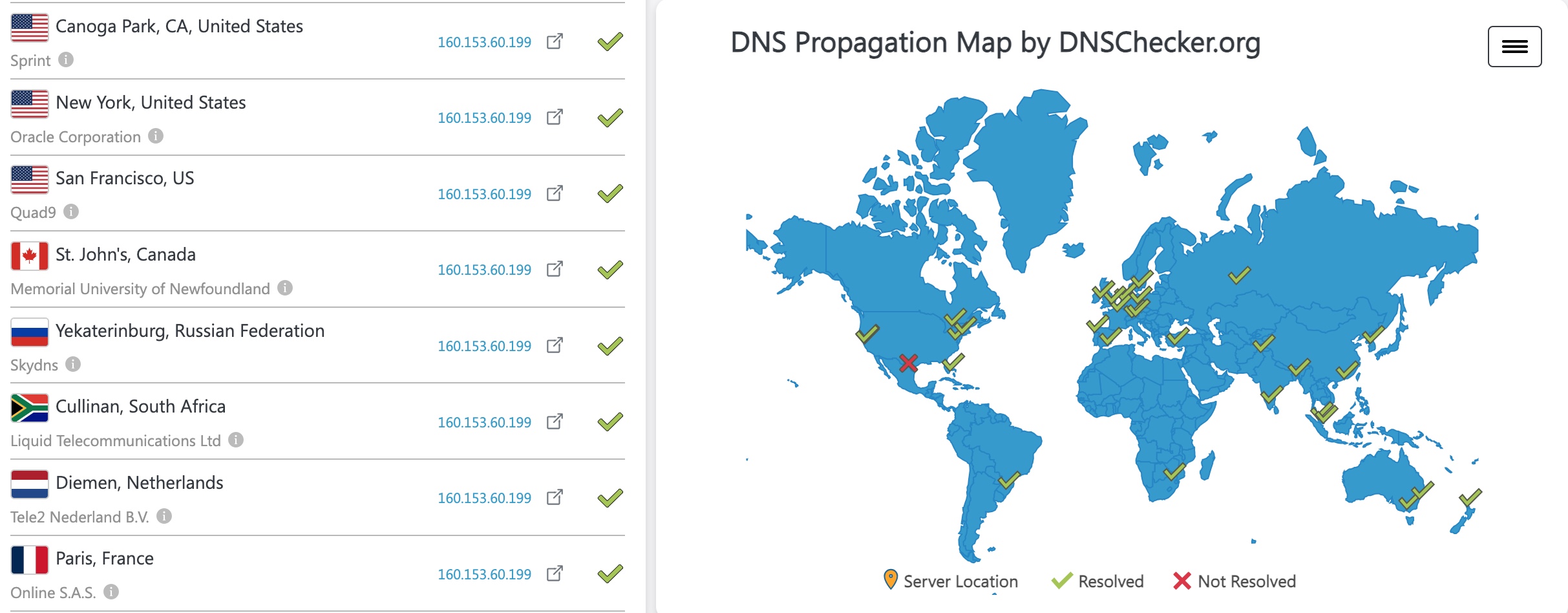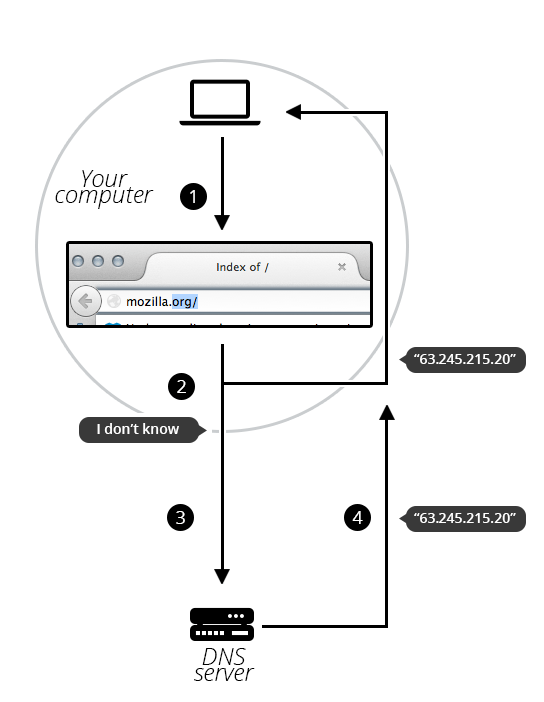WDX-180
Web Development X
What is a Domain Name?
(Updated: 15/08/2023)
Prerequisites:
- First you need to know how the Internet works and understand what URLs are
Objective:
- Learn what domain names are, how they work, and why they are important.
Summary
Domain names are a key part of the Internet infrastructure. They provide a human-readable address for any web server available on the Internet.
Any Internet-connected computer can be reached through a public IP Address, either an IPv4 address (e.g. 192.0.2.172) or an IPv6 address (e.g., 2001:db8:8b73:0000:0000:8a2e:0370:1337).
Computers can handle such addresses easily, but people have a hard time finding out who is running the server or what service the website offers. IP addresses are hard to remember and might change over time.
To solve all those problems we use human-readable Internet addresses called domain names.
Deeper dive
Structure of domain names
A domain name has a simple structure made of several parts (it might be one part only, two, three…), separated by dots and read from right to left:

Each of those parts provides specific information about the whole domain name.
-
TLD (Top-Level Domain).
-
: TLDs tell users the general purpose of the service behind the domain name. The most generic TLDs (
.com,.org,.net) don’t require web services to meet any particular criteria, but some TLDs enforce stricter policies so it is clearer what their purpose is. For example:- Local TLDs such as
.us,.fr, or.secan require the service to be provided in a given language or hosted in a certain country — they are supposed to indicate a resource in a particular language or country. - TLDs containing
.govare only allowed to be used by government departments. - The
.eduTLD is only for use by educational and academic institutions.
TLDs can contain special as well as latin characters. A TLD’s maximum length is 63 characters, although most are around 2–3.
The full list of TLDs is maintained by ICANN.
- Local TLDs such as
-
-
Label (or component)
-
: The labels are what follow the TLD. A label is a case-insensitive character sequence anywhere from one to sixty-three characters in length, containing only the letters
AthroughZ, digits0through9, and the ‘-‘ character (which may not be the first or last character in the label).a,97, andhello-strange-person-16-how-are-youare all examples of valid labels.The label located right before the TLD is also called a Secondary Level Domain (SLD).
A domain name can have many labels (or components). It is not mandatory nor necessary to have 3 labels to form a domain name. For instance, www.inf.ed.ac.uk is a valid domain name. For any domain you control (e.g. mozilla.org), you can create “subdomains” with different content located at each, like developer.mozilla.org, iot.mozilla.org, or bugzilla.mozilla.org.
-
Buying a domain name
Who owns a domain name?
You cannot “buy a domain name”. This is so that unused domain names eventually become available to be used again by someone else. If every domain name was bought, the web would quickly fill up with unused domain names that were locked and couldn’t be used by anyone.
Instead, you pay for the right to use a domain name for one or more years. You can renew your right, and your renewal has priority over other people’s applications. But you never own the domain name.
Companies called registrars use domain name registries to keep track of technical and administrative information connecting you to your domain name.
Note: For some domain name, it might not be a registrar which is in charge of keeping track. For instance, every domain name under
.fireis managed by Amazon.
Finding an available domain name
To find out whether a given domain name is available,
- Go to a domain name registrar’s website. Most of them provide some sort of search option or a “whois” service that tells you whether a domain name is available.
For example, if we visit GoDaddy (one of the world’s larget domain registrars) we can see a search bar that allows us to type in the domain that we want to register:



Ops! It seems that our supercooldomain.com is not currently available.
-
Alternatively, if you use a system with a built-in shell, type a
whoiscommand into it, as shown here formozilla.org:whois mozilla.orgThis will output the following:
Domain Name:MOZILLA.ORG Domain ID: D1409563-LROR Creation Date: 1998-01-24T05:00:00Z Updated Date: 2013-12-08T01:16:57Z Registry Expiry Date: 2015-01-23T05:00:00Z Sponsoring Registrar:MarkMonitor Inc. (R37-LROR) Sponsoring Registrar IANA ID: 292 WHOIS Server: Referral URL: Domain Status: clientDeleteProhibited Domain Status: clientTransferProhibited Domain Status: clientUpdateProhibited Registrant ID:mmr-33684 Registrant Name:DNS Admin Registrant Organization:Mozilla Foundation Registrant Street: 650 Castro St Ste 300 Registrant City:Mountain View Registrant State/Province:CA Registrant Postal Code:94041 Registrant Country:US Registrant Phone:+1.6509030800
As you can see, I can’t register mozilla.org because the Mozilla Foundation has already registered it.
On the other hand, let’s see if I could register afunkydomainname.org:
whois afunkydomainname.org
This will output the following (at the time of writing):
NOT FOUND
As you can see, the domain does not exist in the whois database, so we could ask to register it. Good to know!
Getting a domain name
The process is quite straightforward:
-
Go to a registrar’s website.
-
Usually there is a prominent “Get a domain name” call to action. Click on it.
-
Fill out the form with all required details. Make sure, especially, that you have not misspelled your desired domain name. Once it’s paid for, it’s too late!
-
The registrar will let you know when the domain name is properly registered. Within a few hours, all DNS servers will have received your DNS information.
Note: In this process the registrar asks you for your real-world address. Make sure you fill it properly, since in some countries registrars may be forced to close the domain if they cannot provide a valid address.
DNS refreshing
DNS databases are stored on every DNS server worldwide, and all these servers refer to a few special servers called “authoritative name servers” or “top-level DNS servers” — these are like the boss servers that manage the system.
Whenever your registrar creates or updates any information for a given domain, the information must be refreshed in every DNS database. Each DNS server that knows about a given domain stores the information for some time before it is automatically invalidated and then refreshed (the DNS server queries an authoritative server and fetches the updated information from it). Thus, it takes some time for DNS servers that know about this domain name to get the up-to-date information.
TIP: There are several online tools that enable you to check the process of DNS updating (also called propagation). In the screenshot below, you can see how DNSChecker provides a list of up-to-date DNS servers along with a nice map indicating all the DNS servers along with their status.

How does a DNS request work?
As we already saw, when you want to display a webpage in your browser it’s easier to type a domain name than an IP address. Let’s take a look at the process:
-
Type
mozilla.orgin your browser’s location bar. -
Your browser asks your computer if it already recognizes the IP address identified by this domain name (using a local DNS cache). If it does, the name is translated to the IP address and the browser negotiates contents with the web server. End of story.
-
If your computer does not know which IP is behind the
mozilla.orgname, it goes on to ask a DNS server, whose job is precisely to tell your computer which IP address matches each registered domain name. -
Now that the computer knows the requested IP address, your browser can negotiate contents with the web server.

More Resources
-
Read more about Domain Names on Wikipedia.
-
You can also find here a fun and colorful explanation of how DNS works.
Sources and Attributions
Content is based on the following sources: